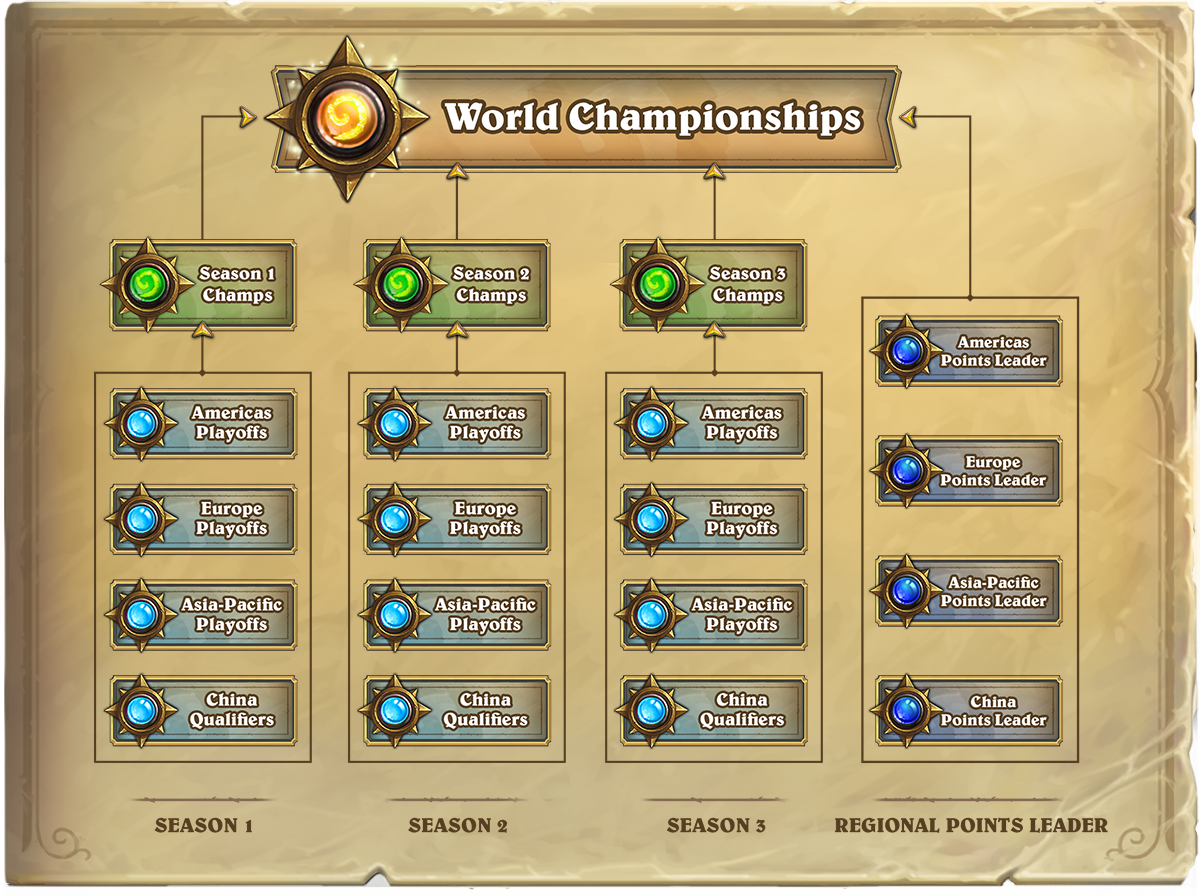
Credit: Blizzard Entertainment
The road to the finals is long and arduous: a combination of ladder grinding and tournament finishes net you a place at the seasonal preliminaries, a 64-man field which is eventually whittled down to just two players. The four regions delegate eight to the seasonal championship, the winners of which make it to the world championship alongside the overall regional top earners. The devil is in the details: the competition is so swift that players regularly play on multiple servers at the same time with their best result counting towards their point total regardless of which region they’ve achieved it in. It’s a fairly prohibitive barrier – especially in Europe, widely considered to be the most competitive region other than China, which has its own unique system, supposedly under heavy strain and neglect – since your collection is locked to whichever server you’re playing on, you are to maintain separate ones everywhere if you want to keep up with the hardcore grinders. It was nine months ago that n0blord posted an excellent treatise on the Hearthstone subreddit about the state of the HCT preliminaries, being one of the few players who have qualified for every single one of them up until that point. Those events feature the 64 highest point-earners per region based on ladder finishes and tournament performances in a given three- or four-month period: he concluded that only two-thirds of them would break even at all, despite making such a strict cut-off."If you ever ask a seasoned competitive Hearthstone player how to get into the scene, most will reply with a short answer: “Don’t do it”.”These playoff events are purposefully held in an offline environment at multiple third-party venues at the same time, leading to a whole host of infamous issues ranging from admin incompetence or the establishment closing down before the qualifier finished. As per n0blord, their locations can be surprisingly sparse, forcing an eight-hour drive from a Washington native to the nearest venue under the best of circumstances. Since there is no disconnection protection in the game, the current standing protocol forces a rematch in case of such incidents unless one of the players had a guaranteed winning board state at the time, leading to many suspicious momentary disappearances by losing players at these events. As for the offline events, Blizzard has really tried to step up this year with regularly organized tour stops, events which were meant to reward consistent tournament performers but were considered by most pros to be a -EV proposition due to the side of the field, the issue with the formats and the difficulty of qualification. The latter has nothing to do with the challenge: the online tour stop qualifiers are on a first-come-first-served basis with a limited bracket size, meaning any random low-rank ladder player can just take up one of the limited slots over a professional player – and the larger ones fill up only a few seconds after registration is opened. These events usually feature a Swiss-style bracket to separate the top eight from the rest and then double-elimination playoffs afterward with best-of-five series all along the way. Since there aren’t enough series played in the Swiss portion, the playoff participants are almost always decided by tie-breakers, which are in turn largely determined by the performances of your randomly assigned opponents throughout the tournament (some of whom may just drop out entirely once it’s clear they won’t be making it through) and how early you dropped your first series. Apart from not rewarding enough points and making it very difficult to perform consistently, many of these tour stops are marred by amateurish organizational issues. HCT Italy’s broadcast looped a 30-second ad for half an hour among other issues while HCT Seoul’s participants were forced to unlock their own cards before the event due to a lack of tournament-ready super accounts. The same event was also infamously marred by controversy over a patch that broke a certain archetype (Quest Druid) which was announced and brought live after the deck submission process ended. Initially, the organizers stated that no one was allowed to change their line-up, then eventually relented and allowed the affected players to change that one particular deck – a decision made after everyone’s submissions were already made public, giving those players a hefty advantage. Traveling to these offline events would be a burden even if you were rewarded for consistent performances – which is why it’s especially galling that Team 5 are planning to increase their numbers in the future, creating even more nameless throwaway winners along the way. It’s a jarring contrast with the fact that not one of Hearthstone’s world champions even managed to make it back to next year’s event, let alone defend their title. On top of it all, competitive events feature the widely criticized Conquest format where you bring four different decks and then ban one of your opponents’ before a best-of-five series where your goal is to win one game with each. The optimal strategy is to “target” a specific deck and hope like hell it can’t squeak past on a 75-25% match-up – rinse and repeat until the end of the tournament. Crucially, no in-game tools or options exist for newcomers to try out such a format, only having the single-game ladder available to them in the client.